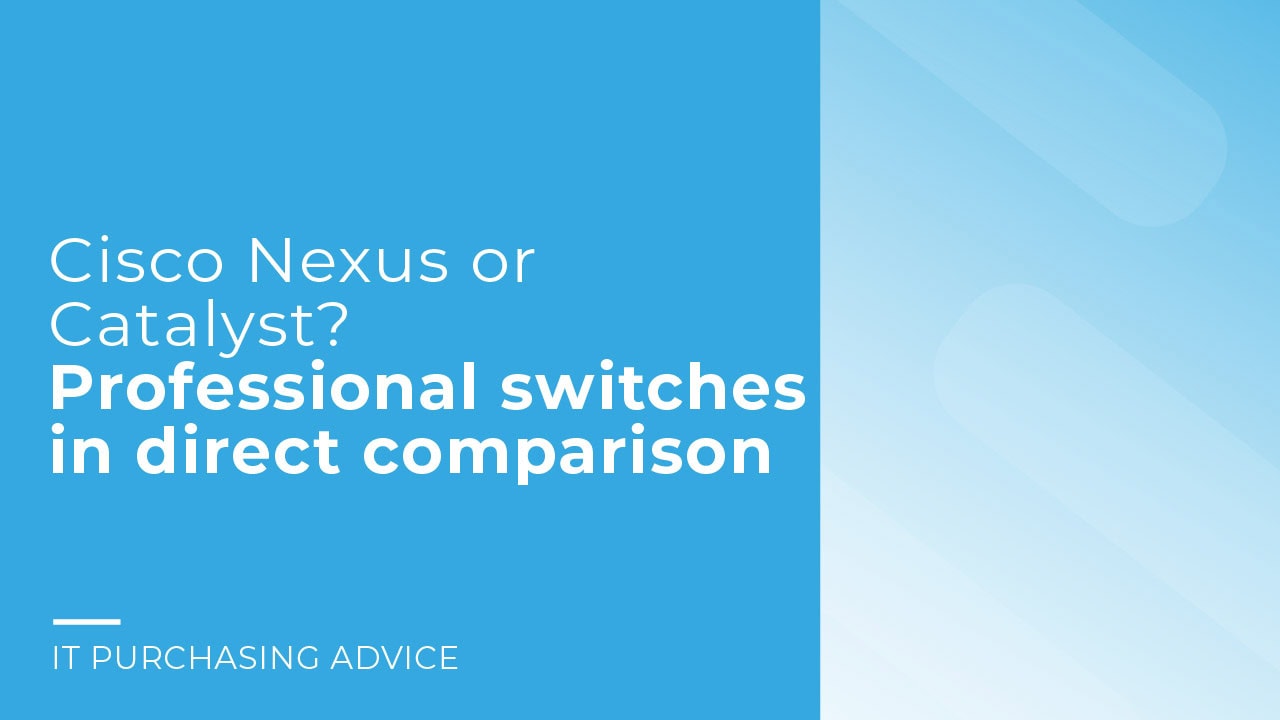
As one of the market leaders in field of network solutions, Cisco is known for its wide range of products. The Cisco Nexus and Catalyst series in particular are often weighed up against each other in a professional context.
Both include switches for high-end solutions - albeit developed for different areas of application.
In short, Nexus is ideal for professional use in data centers and high-performance computing with a focus on scalability, performance and cloud integration. Catalyst offers a flexible, reliable solution for creating complete enterprise networks and campus environments.
The Cisco Catalyst series has been on the market since 1994 and has continued to develop ever since. It includes switches as well as wireless controllers. Wireless access points can be used to set up a complete network. Cisco Catalyst is primarily used in large enterprise networks, for example for campus networks with many users and long-range signals.
The Catalyst series provides a robust and reliable platform for connecting end devices and supporting enterprise applications. It is characterized by its versatility and ease of use. These switches offer advanced security mechanisms, energy efficiency and comprehensive management tools. This enables easy integration and simplified management within the enterprise network. In addition, Catalyst switches support a variety of connectivity options and are known for their durability and stability, making them a preferred choice for many IT departments.
The Cisco Nexus series has been around since 2008 and is specifically designed for servers that handle large amounts of storage and is therefore primarily used in data centers and similar nodes - often as a SAN switch (Storage Area Network Switch), for example.
The Cisco Nexus series is designed for data centers and large networks that require high scalability, performance and flexibility. These switches support innovative technologies such as virtualization and automated network management. They also provide comprehensive security features that enable large amounts of data to be processed efficiently and securely. With an architecture designed for low latency and high bandwidth, Cisco Nexus switches are ideal for companies that want to optimize their IT infrastructure and prepare for future requirements. Read our blog post “Build IT infrastructure and benefit from improved processes” to find out how you can optimize your IT infrastructure.
The Nexus switches use the NX-OS operating system, which you can access in different ways: Either via a web interface, which you can access via the browser, via a serial interface or via the console port. It is configurable and supports the IEEE standard LACP (Link Aggregation Control Protocols).
The Catalyst series relies on Cisco IOS for configuration. Various access options are also available here - from the web interface with graphical user interface to direct access via the console, serial interface, USB 2.0 and the Cisco DNA control unit. In addition to LACP, the operating system also supports PAgP (prot aggregration protocols).
The Cisco Nexus switches offer you the option of setting up Ethernet networks and even faster fiber optic connections. The devices support FCoE (Fibre Channel over Ethernet), which enables the consolidation of storage and data traffic via a single network. These three different connection types in one housing offer you particularly great flexibility and considerably simplify the network architecture. With features such as VXLAN (Virtual Extensible LAN) and extensive support for automation and programmable networks, Cisco Nexus switches are ideally equipped for modern, scalable data centers.
The products in the Catalyst series offer you wired Ethernet connections and WLAN modules via the switches. Together with the wireless access points, you can also extend the range of the WLAN as required. The Catalyst series also includes advanced features such as Application Visibility and Control (AVC), which allow you to monitor and optimize network traffic in real time. With Power over Ethernet (PoE), the Catalyst switches also support powering end devices such as IP phones and cameras directly over the network, simplifying installation and maintenance. These comprehensive functions make the Catalyst series an ideal solution for a wide range of business requirements.
Both series allow you a modular structure and the subsequent adaptation of your IT infrastructure. The switches in the Nexus series are designed for installation in 19-inch racks and are therefore space-saving and easy to expand. Cisco Catalyst products are available with connections per height unit.
There are various sub-categories within Cisco Nexus series are suitable for your application depending on the specific area of use.
Nexus 3000 switches offer high performance and low latency and are therefore ideal for compute-intensive applications and virtualized environments. The Nexus 9000 series is aimed at data centers and communication interfaces with high data throughput.
The Catalyst switches include PoE-capable (Power over Ethernet) devices, such as the Catalyst 3850 switches. These can be used to supply network devices such as surveillance cameras or the wireless access points of the Catalyst Endpoint series directly with power via the Ethernet connection.
With both series, Cisco offers you extensive support and resources to create a network infrastructure on your terms. Which is the right choice for you ultimately depends on your individual requirements.
In modern data centers with a focus on high performance with cloud services, Nexus is often the better solution. If your focus is on flexibility, comprehensive security and support for a wide range of applications in the corporate and campus environment, Catalyst could be the right choice for you.
We would be happy to help you find the right products (both new and refurbished) for your application. Simply contact us using our inquiry form if you would like detailed advice.